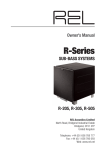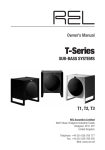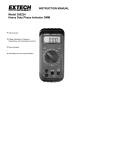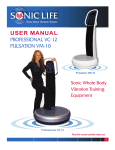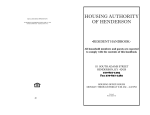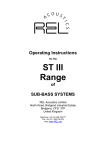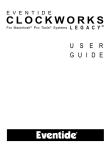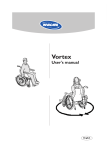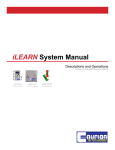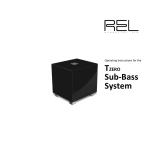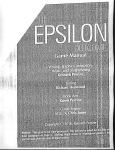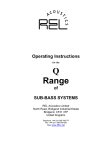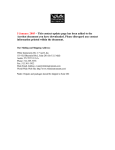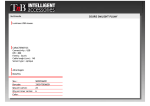Download Serie R Manual - REL Acoustics
Transcript
Operating Instructions for the Serie R Sub-Bass System REL Acoustics Limited North Road, Bridgend industrial Estate Bridgend, CF31 3TP United Kingdom Telephone: +44 (0)1 656 768 777 Fax: +44 (0) 1 656 766 093 Web: www.REL.net Important Safeguards 1 Read all of these instructions. 2 Save these instructions for future use. 3 Unplug from the wall socket before cleaning. Do not use liquid cleaners or aerosol cleaners. Use a damp cloth for cleaning. 4 Keep away from water or other liquids. Do not rest drinks, vases or other liquid-filled items on the unit. 5 Do not place on a stand or table; it may fall causing injury to a child or adult, and damage to the unit. 6 The unit should only be operated from the power source indicated on the panel of the amplifier. 7 Only use the power cord supplied. 8 Do not allow anything to rest on the power cord. Position the power cord such that it cannot be walked on. 9 For added protection during a lightning storm, or when not in use for long periods of time, unplug it from the wall socket. 10 Do not attempt to service the unit yourself, as removing the amplifier may expose you to dangerous voltages. Refer all servicing to your dealer. 11 Unplug the unit from the wall socket and refer servicing to your dealer under the following conditions: a b c d e When the power cord or plug is damaged. If liquid has been spilled onto the unit. If the unit does not operate properly by following the operating instructions. If the unit has been dropped and damaged. When the unit exhibits a drastic change in performance. 12 Ensure that the mains plug and mains switch, used as disconnect devices, are easily accessible and readily operable. Warning This item is heavy. To avoid risk of injury, take care when handling. Welcome Thank you for buying a REL Serie R Sub-Bass System. Each Serie R model is carefully hand-built using the finest materials available and is designed for maximum performance. This manual contains important safety information as well as helpful advice and should be carefully studied before connecting your unit. Service After Warranty All service must be arranged through an authorized REL dealer. Should the unit need to be returned for any reason, all carriage costs will be payable by the customer. Losses or damage caused during transit are the customer’s risk. Design Safety This apparatus is supplied with a detachable mains cord. For North American, UK and all other markets a fuse is fitted in the plug. Should the fuse need to be replaced use the same rated fuse approved to ASTA or BSI 362 (fuse value is indicated on rear panel of each unit). Do not use without the fuse cover in place. Replacement fuse covers are available from your dealer or distributor. 1 About the Serie R Sub-Bass Systems Many or most loudspeakers emphasize the mid-bass. This is the range from 50 – 90Hz. We at REL believe this is an incomplete approach and that loudspeakers need to be supplemented in the lower frequencies for true full range reproduction. All of our designs are true Sub-Bass Systems, meaning they are designed to reproduce very low frequencies (below 30 Hz) that are felt rather than heard. This is because we believe that music is full-range, as are sound effects on movies, and we intend for our products to reproduce all of these sounds, not just a narrow band. The Serie R is equipped to allow you to take full advantage of AC3, Dolby Digital, DTS, MPEG 2 and any other digital sound format that includes a dedicated Low Frequency Effects (LFE) channel. The dedicated LFE input meets the tough specification laid down for digital 3/2.1 channels, usually known as 5.1. The output is nominally flat from 35 – 90Hz. It has a dedicated input level control, which enables users to set the LFE level independently of the processor. This is important because not all processors offer control over this significant parameter. The LFE channel is frequently outputting at 10 dB higher levels than the other channels. The Serie R also has high-level speaker level inputs with their own input level control. Uniquely, both the speaker level and the LFE input can be used simultaneously. This means you may set it up for an audiophile sound with your CD’s or other stereo signals and instantly revert to using the Sub-Bass System as the dedicated LFE component when watching movies. This is a feature of real benefit if you wish to play music in stereo mode in the purist audiophile way and in full 5.1 digital mode. True flexibility! Introduction to the Design of the REL Serie R Sub-Bass Systems Serie R is conceived as the ultimate value proposition in the REL line; possessing many of the performance attributes of our legendary Reference products, yet remaining much more compact and affordable. Compared with the original R-Series that debuted in 2006, this fresh approach offers superior performance in all regards through improved amplification, vastly superior filter networks and upgraded cabinet and driver designs. Additionally, the Model’s R-528 and R-328 feature a down-firing carbon fibre ABR passive radiator that vastly increases the driven surface area, while adding very little additional mass. The performance leap is substantial, not just in sheer output where they excel, but also in drive, ease and musicality. The additional speed mixes with the greater body and heft to produce an altogether more impressive musical event. Note: Serie R model designations are arrived at in the following manner. The first digit (2, 3 or 5) signifies model with performance increasing numerically. The second digit signifies total driver count (active and ABR). The final and third digit is year design commenced, 2008. R-218 features a single down-firing 10” driver in a beautiful, high- gloss lacquered cabinet, driven by a brand new state-of-the-art digital amplifier. In addition to producing remarkably fast, rhythmic bass, this amplifier is extremely energy efficient—an aspect of REL designs that has always been a strength. We chose a down-firing orientation for two reasons; firstly, it allows for beautiful, simple and harmonious styling. As much as, or more so, than any other product category, sub-bass systems come under scrutiny for their size and styling. REL’s designers have striven to achieve a very “quiet” visual design that is understated and elegant making it, in effect, an exceedingly polite houseguest. Secondly, the down-firing design is a classic favorite; what it lacks sonically in projection of bass into the listening area and leading edge attack, it gives back in rich, warm room-filling bass. R-328 represents a serious step-up in performance as it upgrades the active main drive unit to a more potent Heavy 10™ – a driver capable of handling sixty percent greater power and offering superior dynamics and speed. Added to this is a new lightweight, stiff carbon fibre 12” ABR passive radiator that is pitched quite low and thereby avoids the normal slow, plumy quality of typical ABR design. The additional driven surface area that predominantly comes into play at very low frequencies and high amplitudes has the effect of creating a variable cone surface capable of acting like a fast 10” driver for smaller more delicate material, then transforming into the equivalent of a 15” driver when demand calls for it. Internally, REL refers to this progressive driver size as VariCone™. Finally, due to the improved driver, amplifier power is upgraded to 350 watts. 2 R-528 represents the final step-up in the Serie R platform and, as is REL tradition, imbues the largest model in the range with superlative depth and scale. Numbers do not tell the full story here, as the weight and power of R-528 at full song is prodigious indeed. R-528 receives a Heavy 12™ active bass-engine coupled to a VariCone 12” carbon fibre ABR passive radiator producing the equivalent of a 16” driver in a larger cabinet than its smaller brother. A digital power amplifier that produces an effortless 500 watts with the aforementioned components means R-528 is capable of underpinning speakers that cost ten times its own price. R-528 is about speed and detail as well as the Heavy 12™, which is actually the fastest diver in the series with the best impulse response. Naturally, its capabilities suggest careful pairing is in order, but although it is less than a 16” cube, it is up to filling even grand salons with powerful, clean and fast extended low bass. Serie R is the best we can possibly offer at this price point. The cabinets are beautifully braced; more like fine instruments or a fine boat than a normal subwoofer. The amplification is powerful clean, efficient and reliable and the drivers are robustly built. Quality details exist throughout and we expect the Serie R owner to be very pleased with their decision for years to come. REL Serie R Rear Panel Connection Legend 1 2 8 3 7 4 5 6 9 1 Crossover: Used to select crossover frequency. Variable between 32 – 120Hz. 2 Volume Control for HI/LO input: Use to adjust output when using either HI Level or LO Level input. Do not use both simultaneously. 3 Volume Control for .1/LFE Input: Use to adjust output level when using .1/LFE input from a 5.1 amplifier or processor. 4 Phase: Used to set phase 0-180 degrees. 5 Low-Level Phono Input: Used to connect low-level to the subwoofer output of a preamplifier, integrated amplifier or receiver. (For home cinema use, use .1/LFE input) 6 .1/LFE Phono Input: Used to connect to the .1/LFE output from a 5.1 amplifier of processor. 7 High-Level Neutrik® Speakon® Socket: Used to connect high-level to the main front amplifier speaker terminals. 8 Power ON/OFF Switch: Used to turn unit on or off. 9 IEC Mains Socket: Fused mains (AC) input socket that accepts a detachable power cord. 3 Connecting Up Always switch off your system before connecting or disconnecting any wires. To increase the versatility of connecting up, each Serie R model is equipped with two separate inputs. A Neutrik Speakon socket and a single phono socket. This is to facilitate use with both two channel stereo systems and AV surround sound systems. The high-level, unbalanced, dual-channel (stereo) input is via a Neutrik Speakon connector, which is connected to the power amplifier’s left and right channel speaker terminals. This has the advantage of ensuring that the REL receives exactly the same signal as the main speakers. This means that the character of the bass from the main system is carried forward into the sub-bass. This is a very important point and together with the REL’s Active Bass Controller (ABC), ensures far superior system integration of the sub-bass with the main system. The low-level input is via two separate phono jacks that connect to either the .1/LFE output of a home cinema amplifier/processor or to the subwoofer output of a stereo preamplifier. HI LEVEL and .1/LFE inputs can be used simultaneously. The benefits are two-fold when used with a home cinema system. The low level input reproduces the .1 Sub/LFE channel and the high level connection underpins the main front speakers. The main front speakers should be set to the ‘large’ option on the processor. See “Home Cinema Applications” Connecting to a Power Amplifier Using the Neutrik High Level Input To engage the Neutrik Speakon plug, insert fully into socket and rotate clockwise until locked. To remove the Neutrik Speakon plug, grip body of plug, place thumb on chrome lever, move lever backwards rotate plug anti-clockwise quarter turn and withdraw. The high-level input is designed to accept the stereo (two-channel) signals from the speaker terminals of your receiver, integrated amplifier, and basic amplifiers. This has the advantage of ensuring that your subwoofer receives exactly the same signal as the main speakers, which means that the character of the bass from the main system is carried forward into the Sub-Bass System. This is a very important point and together with REL’s Natural RollOff™ circuitry, ensures far superior system integration of the Sub-Bass System with the main system. High-Level Input: Connections should be made to the same binding post on main amplifier as the main speakers. Connect as shown above. Red to amplifier main right speaker red terminal, yellow to amplifier main left speaker red terminal and black to amplifier main speaker black terminal, right or left but not both. Plug the Neutrik Speakon plug into the HI LEVEL Neutrik socket. 4 Using the Low-Level Inputs .1 Input: This requires a phono-to-phono cable and is a dedicated true .1 channel. This circuit therefore eliminates the normal Natural RollOff Crossover and passes the .1 low-level signal through with only the required 120Hz 4th order crossover. Low-Level Input: This single channel phono input allows for conventional connection to a preamplifier and should be used in the rare event that a high-level connection proves incompatible. Connect as shown below. Plug one end into the preamplifier output and the other into the low-level input on the sub-bass system. To obtain signal from both channels requires purchase of a Y-adaptor that is available from most parts stores. Phase Switch Phase reversal can be useful as explained in “SETTING UP”. PHASE SWITCH – Used to set phase Position 0 / High-Level or LFE: 0 degrees phase Position 180 / High-Level or LFE: 180 degrees phase PHASE SELECTION AFFECTS BOTH HI AND LO LEVEL INPUTS REL Set-Up Made Simple REL products are not traditional subwoofers, but true Sub-Bass Systems. A REL is designed to augment the performance of “full range” speaker systems, in order to provide, in certain cases, linear response down to below 12Hz. Therefore, for the moment, set aside everything you’ve been taught about subwoofers and how they are integrated into a stereo or home cinema system. REL Sub-Bass Systems set-up and positioning differs from conventional subwoofers. A REL will take advantage of physics and room acoustics to provide deep pressurization as no traditional subwoofer can. It’s important that you bring to the set-up process a willingness to do things a little differently in order to obtain these superior results. The end result of your labours will be an utterly seamless integration of true deep bass to a sound system, regardless of the main speakers’ low bass capability. Basic set-up should take no more than ten to fifteen minutes to accomplish once connected. Two Things Before You Begin 1 It is helpful to know that you will almost always connect the REL using the input on the rear panel labeled “HIGH LEVEL INPUT.” This connection is made using the supplied 34’ 10” (10 meters) cable, the bare leads of which connect to the speaker output terminals of the power amplifier. The easy and foolproof connection at the REL is done with a Neutrik Speakon connector. The purpose of connecting to the speaker output terminals is one of the unique secrets of REL’s success. By connecting to the high-level input on the REL from the amplifier, you build forward the sonic signature of your main system, including the tonal balance and timing cues of the entire electronics chain. In this way, the REL is fed the exact signal that is fed to the main speakers. 5 2 When possible, the REL should be placed in one of the corners behind the speakers. Remember, we are dealing with true LOW bass pressurization with RELs. Low bass pressurization below 40Hz is best derived from corner placement, where the most linear and efficient low bass can be produced. Connecting and Setting Up High-level connection, using the enclosed cable with the Neutrik Speakon connector, is always the first choice. This connection can be made without affecting the performance of the amplifier because the REL’s amplifier input impedance is 150,000 ohms, in effect not producing any additional demand whatsoever on the rest of your system. This scheme also avoids adding any detrimental effects by not interposing any additional electronics into the amplification chain. • The standard high-level hook up procedure is: attach the red wire to the amplifier’s right positive speaker output terminal; attach the yellow wire to the amplifier’s left positive speaker output terminal; attach the black wire to whichever of the amplifier’s ground output terminals is convenient; plug the Speakon connector into the Sub-Bass System’s HIGH-LEVEL INPUT. • For differential (i.e. fully balanced) amplifiers using one REL, simply use the standard connecting scheme with the exception of connecting the black wire to chassis ground (i.e. a metal bolt or screw, preferably not painted or anodized, on the chassis of the power amp or receiver), not to a negative speaker terminal, and then connecting into the HIGH-LEVEL INPUT on the REL. Please contact your dealer should there be any questions concerning this or any other hookup procedure. Low-level connection (via phono connectors) is always an option if high-level connection is not possible. When connecting to the low-level inputs in a system in which high-level connection is not possible, connect a single phono cable to the LOW-LEVEL INPUT jack. If you are connecting two channels of stereo output from a pre-amplifier, simply use a high-quality y-adapter to sum the two signals together. When connecting to a home cinema system where there is a .1/LFE channel output, connect a single phono cable between the sub out of the processor/receiver and the .1/LFE INPUT jack on the REL. 1 Positioning: The optimal position for a REL is in one of the corners behind the main speakers. This position provides 9 dB of mechanical amplification and allows for the most linear true low bass wave launch, owing to the ability to tune the REL to the longest distance in the room in order to produce the longest, therefore lowest, bass waves. 2 The Process: To begin the set-up process, choose a piece of music that has a repetitive bass line that is very low in frequency. We recommend track 4 from the soundtrack to Sneakers (Columbia CK 53146). This has a repetitive bass drum throughout that gives you plenty of time to move the woofer around, but more importantly, the recording venue was quite large for this recording, and therefore it has a very deep and large-scale bass signature. This type of track is perfect for the set-up process, and should be played at the highest reasonable level expected for system playback. Working with a partner, one in the listening position and one at the REL manipulating the controls, is the most effective and efficient way to set up the REL. If working alone, the initial steps in the set-up can be very effectively carried out from the location of the REL. Trying to ignore all other music in the track, listen for the bass drum and its effect on the listening room. 3 Phase Orientation: Once in the corner we need to adjust for phase. This may be the single most critical step, and because it really is quite simple, it is often over-thought. Keep in mind; the right phase is whichever position is the loudest or fullest. While playing music with true low bass, adjust the crossover to a point where the REL and the speaker are sure to share frequencies (about halfway up, or at 12 o’clock on the crossover control, or slightly higher for smaller speakers). At this point turn the hi/lo level control up so that both the REL and speaker are roughly equal in volume and then switch, using the phase switch, from “0” to “180” phase positions. Again, whichever position is loudest or fullest is the correct position. That is, when the position is working in harmony with your main speakers, reinforcing bass, and not canceling it. 6 4 Placement: The next step is to determine precisely how far out from the corner the sub should be placed to achieve the most efficient output, as well as the lowest frequency extension. With the REL fully into the corner, and pointing straight out along the diagonal coming out of the corner, continuing to play the music, slowly pull the REL from the corner on the diagonal, equidistant from both side and rear wall. At a certain point (sometimes a matter of only a few inches, in rare cases a foot or more) the REL will audibly go lower, play louder, and, if it truly locks on to the room and is fully pressurizing it, the air around the REL will seem to be energized, stop right there! This is the correct position from the corner for the REL. 5 Orientation: Once the position from the corner has been established, the orientation of the woofer must be determined by rotating the REL from an imagined centre point at the rear of the REL. As the REL is moved from one side to the other listen for the greatest level of output and bass linearity. In effect, the REL should be left in the position where it is playing the loudest and lowest. 6 Crossover and Level Settings: To determine the crossover point, take the volume of the REL (using the HI/LO Level control) all the way down, and put the crossover to 30Hz minimum. At this point, bring the REL’s volume back up slowly to the point where you have achieved a subtle balance, i.e. the point at which you can hear the REL even with the main speakers playing. Now, bring the crossover point up until it is obviously too high; at this point bring it down to the appropriate lower setting. For all intents and purposes, this is the correct crossover point. Once this stage has been reached, subtle changes to volume and crossover can be accomplished to provide the last bit of complete and seamless integration. With that, set-up is complete. Hint: There may be a tendency to set the crossover point too high and the volume of the Sub-Bass System too low when first learning how to integrate a REL with the system, the fear being one of overwhelming the main speakers with bass. But in doing so, the resulting set-up will be lacking in bass depth and dynamics. The proper crossover point and volume setting will increase overall dynamics, allow for extended bass frequencies, and improve soundstage properties. Note: Volume must be adjusted in conjunction with crossover changes. In general, when selecting a lower crossover point, more volume may need to be applied. Home Cinema Applications For Dolby Digital AC-3 or other 5.1 theatre systems, once the standard set-up for two-channel outlined above is complete, the LFE output from the processor or receiver should be connected to the .1/LFE INPUT and appropriate volume adjustments made using the .1/LFE level control. For this configuration, you must set the processor to the “large” or “full range” setting for the left and right speakers in order for the REL to receive the bass signal via the high-level cable. In this configuration, the REL provides support for both the left and right speakers for two-channel listening, and support for the LFE when movies are playing. Most processors will allow you to defeat the subwoofer output when listening in the two-channel mode. The effect of this set-up is one of greatly increased dynamics in the mid-bass range, no bass bloat, and a greater degree of space and timing from the special audio effects. For an even greater sense of space and impact, a second REL connected in parallel to the centre channel will prove to be a dramatic improvement as well. And if that is not enough fun, a rear REL, both to support the rear channel speakers as well as to evenly distribute LFE through the room, truly completes the full-range sonic picture for state-of-the-art film reproduction. Running In Care taken over running in will be rewarded by many years of pleasurable use. Both the electronics and the drive unit will benefit from an initial period of carefully controlled use. Possible damage may be sustained by running in the unit at too high a volume setting over an extended period. On the other hand, by taking a little care over this initial period, about 24 hours of actual use, a longer life with a higher potential eventual performance is assured. Care and Polishing The cabinets are best maintained by using a spray-on wax, such as an automobile wax made by a company called Griot’s. If objects are to be placed upon the top, it is advisable to use a small mat to protect the surface and to avoid the risk of rattles. 7 Technical The Serie R models use an unusual method of bass loading. It is designed to operate below normal system resonance. This has been achieved without the normal form of bass boost or electronic equalization. Instead of a constantly increasing bass equalization response, we simply ensure there is sufficient amplifier gain to drive the speaker unit to its maximum excursion level at whatever the designated lowest operating frequency is, and then cut the bass at a controlled rate of 12 dB per octave above this frequency. Although this may at first seem identical to boosting the bass, it is actually quite different and ensures that the timing of transients is far improved compared to the usual bass equalization used. Bass will sound cleaner and faster. The amplifier is fully DC coupled to avoid phase shifts and compromises in its low-end performance. It is inherently stable and will retain its characteristics over very long periods of time – important in a unit designed for an exceptionally long working life. These amplifiers are designed to withstand reasonable abuse and overloads. If in doubt, please contact your dealer. We believe that the importance of the electronics, cabinet and drivers being designed to work in harmony is paramount. This belief allows the Serie R to achieve the highest possible level of fidelity. Overload Protection All REL Sub-Bass Systems are designed as true sub bass speakers. They are designed to reproduce those exceptionally deep notes that are felt rather than heard. This it will attempt to do at whatever volume level you set. If set too high no damage should result because the built-in electronics will limit the cone movement. This electronic control is called Set-Safe™. It constantly and instantaneously monitors the output from the power amplifier and is totally transparent in operation until required. This means it has absolutely no effect on the sound quality of your REL until an overload is detected. Ordinarily an overload would cause the power amplifier to go into clipping with resultant loss of control over the drive unit. This can cause drive unit damage, and always sounds nasty. Set-Safe™ detects the point of incipient clipping and gently soft clips the waveform of the signal to ensure actual clipping does not occur. This is a necessarily simplified description of what actually happens, but in effect, Set-Safe controls the amplifier and ensures there is minimum risk of amplifier and driver damage caused by over-driving. A thermal overload device is fitted to all R-Series Sub-Bass Systems. If the unit is deliberately overdriven this device will sense the temperature rise and cut the output; recovery time is approximately five minutes. If this happens, it is a warning that the unit is being overdriven and the volume level control should be reduced to a safe level. Although everything possible has been done to minimize risk of thermal overload failure, there can be no defense against those individuals who deliberately abuse the device. Such damage is NOT covered by warranty. Please remember your REL is there to supplement your main system, not overwhelm it! Power Saving Efficiency All REL Sub-Bass Systems are designed for maximum power efficiency, both when passing a signal through to its resultant output sound into the room and also when silent. REL circuitry is designed for “power starvation” operation under no signal conditions. This means that immediately when there is a gap in the signal the REL is instantly at maximum power saving efficiency, yet remains at maximum readiness to respond immediately to a sudden transient signal, such as an explosion in a movie, even after a long quiet period and regardless of level. This compares to some “auto power on/off systems” which remain powered up for a set period of no-signal condition (up to 10-15 minutes) and which need to power-up on receipt of a sudden transient, thus failing to catch the start of that transient. There is also the possibility of the unit remaining inoperative during listening sessions where the overall volume is low. It is not necessary to switch off between listening sessions – it will not significantly shorten its life by leaving it switched on. On the other hand, it will not harm sound quality if it is always switched off. The power consumption in the quiescent (no signal) state is negligible. It is perfectly safe under all normal domestic circumstances as it is fully protected by internal fuses and an external mains fuse in the fuse holder of the mains input socket, with a spare inside this holder. 8 R-528 Specifications Type: Active Drive Unit: Passive Radiator: Lower Frequency Response in Room: Input Connectors: Gain Control Range: Power Output: Phase Switch: Amplifier Type: Protection System Fully Electronic with SET-SAFE: D.C. Fault: Output Short: Mains Input Voltage: Fuses: Passive Radiator, front-firing active woofer, down-firing passive radiator 12 in., 300mm long-throw, steel chassis 12 in., 300mm 21Hz at -6 dB Hi Level Neutrik Speakon, Lo Level single phono, LFE phono 80 dB 500 watts (RMS) Yes, 0 or 180 degrees Class D Yes Yes Yes 220-240 volts, 110-120 volts for certain markets 5 Amp semi delay 230 volts operation 9 Amp semi delay 115 volts operation Dimensions W x H x D, Including Feet and Rear Panel Controls: Net Weight: Finish 15.5 x 17.5 x 17.2 in., (394 x 445 x 436 mm) 58 lbs. (26.3 kg) Gloss Piano Black Lacquer Supplied Accessories Mains Lead: Neutrik Speakon Interconnect 10 Metres Nominal: Users Manual: Yes Yes Yes 9 R-328 Specifications Type: Active Drive Unit: Passive Radiator: Lower Frequency Response in Room: Input Connectors: Gain Control Range: Power Output: Phase Switch: Amplifier Type: Protection System Fully Electronic with SET-SAFE: D.C. Fault: Output Short: Mains Input Voltage: Fuses: Passive Radiator, front-firing active woofer, down-firing passive radiator 10 in., 250mm long-throw, steel chassis 12 in., 300mm 22Hz at -6 dB Hi Level Neutrik Speakon, Lo Level single phono, LFE phono 80 dB 350 watts (RMS) Yes, 0 or 180 degrees Class D Yes Yes Yes 220-240 volts, 110-120 volts for certain markets 4 Amp semi delay 230 volts operation 8 Amp semi delay 115 volts operation Dimensions W x H x D, Including Feet and Rear Panel Controls: Net Weight: Finish 13.5 x 15.1 x 15.2 in., (343 x 384 x 385 mm) 45 lbs. (20.4 kg) Gloss Piano Black Lacquer Supplied Accessories Mains Lead: Neutrik Speakon Interconnect 10 Metres Nominal: Users Manual: Yes Yes Yes 10 R-218 Specifications Type: Active Drive Unit: Lower Frequency Response in Room: Input Connectors: Gain Control Range: Power Output: Phase Switch: Amplifier Type: Protection System Fully Electronic with SET-SAFE: D.C. Fault: Output Short: Mains Input Voltage: Fuses: Down-firing active woofer 10 in., 250mm long-throw, steel chassis 25Hz at -6 dB Hi Level Neutrik Speakon, Lo Level single phono, LFE phono 80 dB 250 watts (RMS) Yes, 0 or 180 degrees Class D Yes Yes Yes 220-240 volts, 110-120 volts for certain markets 3.15 Amp semi delay 230 volts operation 6.3 Amp semi delay 115 volts operation Dimensions W x H x D, Including Feet and Rear Panel Controls: Net Weight: Finish 12 x 13.6 x 12.5 in., (305 x 346 x 318 mm) 29 lbs. (13.2 kg) Gloss Piano Black Lacquer Supplied Accessories Mains Lead: Neutrik Speakon Interconnect 10 Metres Nominal: Users Manual: Yes Yes Yes In the interest of product development, REL Acoustics Limited reserve the right to vary these specifications without notice. 11












